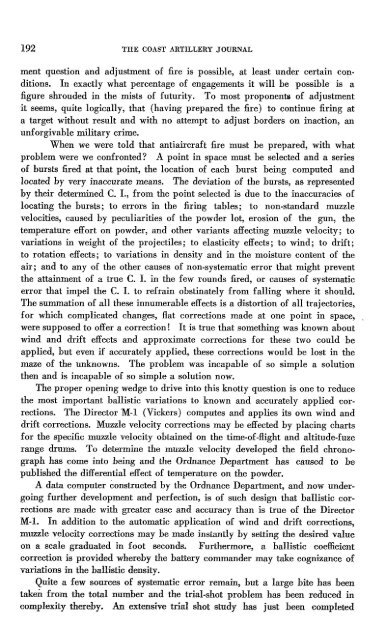THE COAST ARTILLERY JOURNAL - Air Defense Artillery
THE COAST ARTILLERY JOURNAL - Air Defense Artillery
THE COAST ARTILLERY JOURNAL - Air Defense Artillery
Create successful ePaper yourself
Turn your PDF publications into a flip-book with our unique Google optimized e-Paper software.
192 <strong>THE</strong> <strong>COAST</strong> <strong>ARTILLERY</strong> <strong>JOURNAL</strong><br />
ment question and adjustment of fire is possible, at least under certain conditions.<br />
In exactly what percentage of engagements it will be possible is a<br />
figure shrouded in the mists of futurity. To most proponenti of adjustment<br />
it seems, quite logically, that (having prepared the fire) to continue firing at<br />
a target without result and with no attempt to adjust borders on inaction, an<br />
unforgivable military crime.<br />
When we were told that antiaircraft fire must be prepared, with what<br />
problem were we confronted? A point in space must be selected and a series<br />
of bursts fired at that point, the location of each burst being computed and<br />
located by very inaccurate means. The deviation of the bursts, as represented<br />
by their determined C. 1., from the point selected is due to the inaccuracies of<br />
locating the bursts; to errors in the firing tables; to non-standard muzzle<br />
velocities, caused by peculiarities of the powder lot, erosion of the gun, the<br />
temperature effort on powder, and other variants affecting muzzle velocity; to<br />
variations in weight of the projectiles; to elasticity effects; to wind; to drift;<br />
to rotation effects; to variations in density and in the moisture content of the<br />
air; and to any of the other causes of non-systematic error that might prevent<br />
the attainment of a true C. I. in the few rounds fired, or causes of systematic<br />
error that impel the C. 1. to refrain obstinately from falling where it should.<br />
The summation of all these innumerable effectsis a distortion of all trajectories,<br />
for which complicated changes, flat corrections made at one point in space,<br />
were supposed to offer a correction! It is true that something was known about<br />
wind and drift effects and approximate corrections for these two could be<br />
applied, but even if accurately applied, these corrections would be lost in the<br />
maze of the unknowns. The problem was incapable of so simple a solution<br />
then and is incapable of so simple a solution now.<br />
The proper opening wedgeto drive into this knotty question is one to reduce<br />
the most important ballistic variations to known and accurately applied corrections.<br />
The Director M-l (Vickers) computes and applies its own wind and<br />
drift corrections. Muzzle velocity corrections may be effectedby placing charts<br />
for the specific muzzle velocity obtained on the time-of-flightand altitude-fuze<br />
range drums. To determine the muzzle velocity developed the field chronograph<br />
has come into being and the Ordnance Department has caused to he<br />
published the differential effect of temperature on the powder.<br />
A data computer constructed by the Ordnance Department, and now undergoing<br />
further development and perfection, is of such design that ballistic corrections<br />
are made with greater ease and accuracy than is true of the Director<br />
M-l. In addition to the automatic application of wind and drift corrections,<br />
muzzle velocity corrections may be made instantly by setting the desired value<br />
on a scale graduated in foot seconds. Furthermore, a ballistic coefficient<br />
correction is provided whereby the battery commander may take cognizance of<br />
variations in the ballistic density.<br />
Quite a few sources of systematic error remain, but a large bite has been<br />
taken from the total number and the trial-shot problem has been reduced in<br />
complexity thereby. An extensive trial shot study has just been completed
















